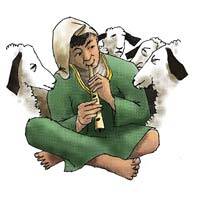Following the Good Shepherd
This Sundays selection from John 10 features two short parables about shepherds and sheepgates. The first parable contrasts the good shepherd with a thief or a stranger. We are to imagine a large pen where the sheep stay when they are not in the fields at pasture. Unlike a thief or stranger, the good shepherd enters through the gate, calls his sheep by name and leads them out. They follow him not because they are stupid, but because they know and trust the shepherd. Who is the shepherd? Psalm 23 reminds us that shepherd is a prominent biblical image for God. The point of the parable is that as God the shepherd acts, so Jesus the shepherd acts. In Johns Gospel there is no sharp dividing line between Jesus and the Father.
In the second parable the focus is on the gate for the sheep. Here Jesus identifies himself as the sheepgate. Whoever enters the pen through him will be safe and well cared for. Here Jesus is the way to the Father, the one who gives us direct and personal access to the creator and lord of all things. This is the abundant life that Jesus promises. His promise summarizes the spirit and goal of the Easter season. It reminds us that our life in Christ is a precious gift, and that the fullness of life resides in the intimate relationship with God made available for us through the paschal mystery.
How we become part of this abundant life is indicated by the conclusion in Acts 2 of Peters speech at Pentecost. There Peter proclaims that the proper response to the good news about Jesus is to repent and be baptized in the name of Jesus Christ. Thus we become members of the Good Shepherds flock.
The images of sheep and shepherd are also prominent in todays reading from 1 Peter 2. Here Peter seeks to encourage suffering Christians by appealing to the sufferings of Jesus the Servant of God, after the pattern set forth in Isaiah 53. Recall that there the Servant was described as like a lamb led to the slaughter or a sheep before his shearers. Peter shows how Jesus, the innocent sufferer, was a model of patience and trust in God, and that his suffering has enabled us to become more fully children of God (by his wounds you have been healed). Through his resurrection the slain Lamb has become for straying sheep the shepherd and guardian of your souls. This startling transformation is a neat summary of what Christians believe about the paschal mystery.
This article also appeared in print, under the headline “Following the Good Shepherd,” in the March 31, 2008, issue.








